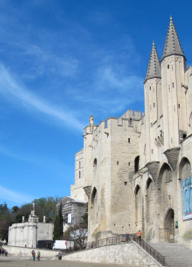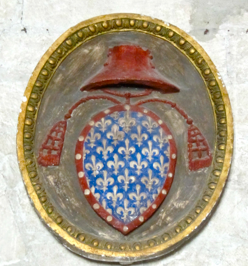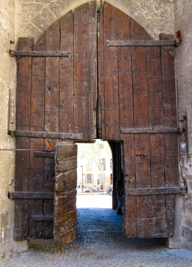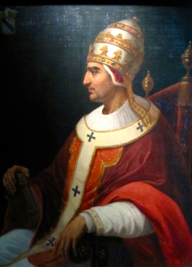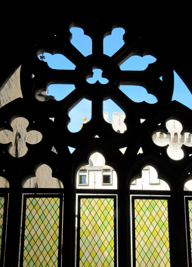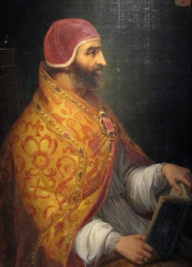palais des papes
avignon
Provence-Alpes-Côte D’Azur, france
europe


palais des papes
avignon
Provence-Alpes-Côte D’Azur, france
europe

The 14th century Palais des Papes in Avignon is considered to be the largest and most important medieval gothic building in Europe. A UNESCO World Heritage Site since 1996, the majority of the palace is now open to the public. This was the second time Henry and I visited this site, this time finding the amount available to see had grown immensely since our first visit to Avignon, now with excellent signage and free audio guides available in English. Avignon became the papal enclave for 68 years when Clement V, a Frenchman elected pope in 1305, refused to move to the chaos of Rome. The seven popes who reigned in Avignon were all French, and all were increasingly under the influence of the French crown, therefore modeling the papal enclave after the court of the French kings.*1 During more than six decades, the papal palace grew, principally in two distinct phases: the Palais Vieux or Old Palace, built on the site of the razed episcopal palace, was constructed by Benedict XII (r. 1334-1342) with the architect Pierre Poisson. The Palais Neuf or New Palace was built by Clement VI (r. 1342-1352), who commissioned the architect Jean de Louvres to build a new tower and two adjoining buildings. These buildings included a 52 meter/170 foot long Grand Chapel to serve as the location for papal acts of worship. The Palais des Papes, built on a natural rocky outcrop at the northern edge of Avignon overlooking the Rhône River, eventually covered 2.6 acres or an area of 11,000 square meters/or 118,403 square feet. In 1377, Pope Gregory XI moved his court to Rome, officially ending the Avignon papacy. Following this, between 1378 and 1417, there was a second line of popes, antipopes who reigned at Avignon, caused by a breakdown in relations between the cardinals and the successor to Gregory’s, Urban VI that gave rise to the “Western Schism”. This schism was ended after only two popes had reigned in Avignon in opposition to the papacy in Rome: Clement VIII and Benedict XVIII*2. The last of these popes was expelled from Avignon and fled to Perpignan in 1403. Parties within the Roman Church were divided in their allegiances among the various claimants to the office of the pope, a problem resolved by The Council of Constance in 1417. The Palais des Papes gradually deteriorated over the following 350 years, and was sacked by revolutionary forces during the French Revolution of 1789. The palace was used by the Napoleonic French state as a military barracks and a prison, and during the Third Republic, the interior woodwork was removed, the frescoes covered over and destroyed and the buildings used as stables. The palace was vacated in 1906, becoming a national museum, and has been under restoration since that time.
*1 According to our guidebook, the Avignon Popes were not known for their sanctity.For example, Clement V died eating powdered emeralds, prescribed as an indigestive cure; Clement VI thought the best way to honor God was through luxury. Petrarch, the historian, was shocked by “the filth of the universe” at court. The only history told by the audio guide that alludes to the luxurious lifestyle of this papal palace was a description of dining here in the 14th century The pope was seated on a dais, and was only one of two people allowed to use a knife, the pope’s was a pearl handled instrument. The other knife was used by the master carver who expertly carved the meat served into bite-sized pieces for the other diners. When the king visited, he was also seated on a separate dais alone, beneath the pope. Diners in this grand, barrel vaulted hall were served between four and nine courses. The description of the food purchased for one occasion was mind boggling in numbers and weights. All the food was prepared in a round kitchen with a central chimney, approximately 20 meters high, where spits in tiers of rotisserie and ovens were stacked atop one another to cook the huge quantities of game, beef, lamb, pork, goose, ducks, hens bread, etc. etc. etc! There was also a cold room to preserve fruit and vegetables for the palace.There was a large retinue of people to plate and serve the food. The plated food was kept warm in front of a huge fireplace that was screened from the rest of the dining hall.
*2 Of the nine popes that reigned in Avignon, two of them were antipopes. The definition the antipope: A person who opposes a legitimately elected or sitting Pope and makes significantly accepted competing claim to be the Pope, the Bishop of Rome and the leader of the Roman Catholic Church. At times between the 3rd and the mid-15th centuries, antipopes were typically those supported by a fairly significant faction of religious cardinals and secular kings and kingdoms.
The seven popes who reigned in Avignon were:
Pope Clement V (1305-1314) • Pope John XXII (1316-1334) • Pope Benedict XII (1334-1342) • Pope Clement VI (1342-1352) * Pope Innocent VI (1352-1362) • Pope Uban V (1362-1370) and Pope Gregory X (1370-1378).
The two antipopes who reigned in Avignon, after the papacy returned to Rome included: Clement VII (r.1378-1394) and Benedict XIII (r.1394-1423)
PHOTOS: Left Column: 1. View of historic Avignon as seen from a leaded glass window in the Palais du Pape. 2. Style of dress: Portrait of one of the the nine popes (7 official popes and 2 antipopes) who reigned in Avignon between 1309 and 1376. 3. Champeaux Gate, the wooden gateway to the Palais des Papes, studded with nail heads on the front side. Center, Top: Turrets positioned at the entrance to the Palais des Pape. The Champeaux gate stands centered beneath the two towers. Center, Middle: Symbol of the Pope, from the walls of the Chambre Parement, the name referring to the tapestries that once decorated the walls of the room. This was an antechamber to the pope, serving as a transition between the public spaces and the private quarters. It was in this space that the pope presented an annual award, the Golden Rose, to a person of honor, usually royalty. Center, Bottom: View of Benedict XII’s cloister with the Bellower that anchored two sides of the fortress architecture. Right Column: 1. View of the complex of towers of the Palais des Papes, or Pope’s Palace located in the center of the historic walled city of Avignon. 2. Style of dress: Portrait of one of the the nine popes (7 official popes and 2 anti-popes) who reigned in Avignon between 1309 and 1376. 3. View from the interior of the Palais des Papes overlooking the interior courtyard: a Medieval window with trefoil patterns and stained glass.


Residence of the Popes
